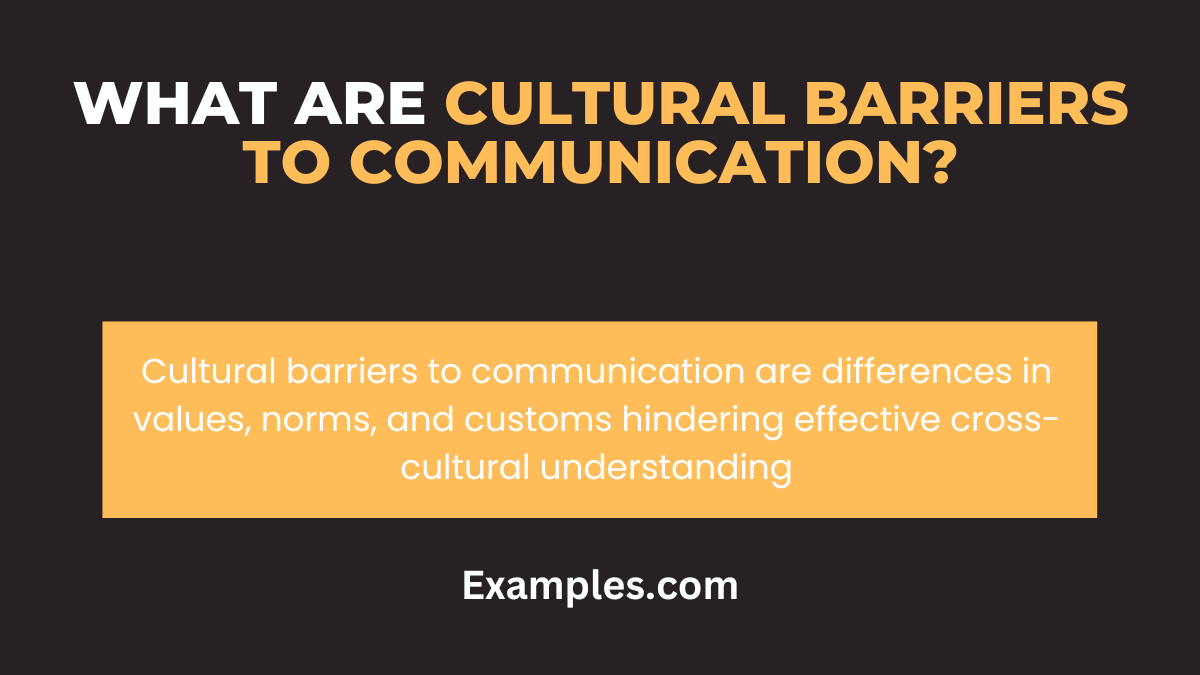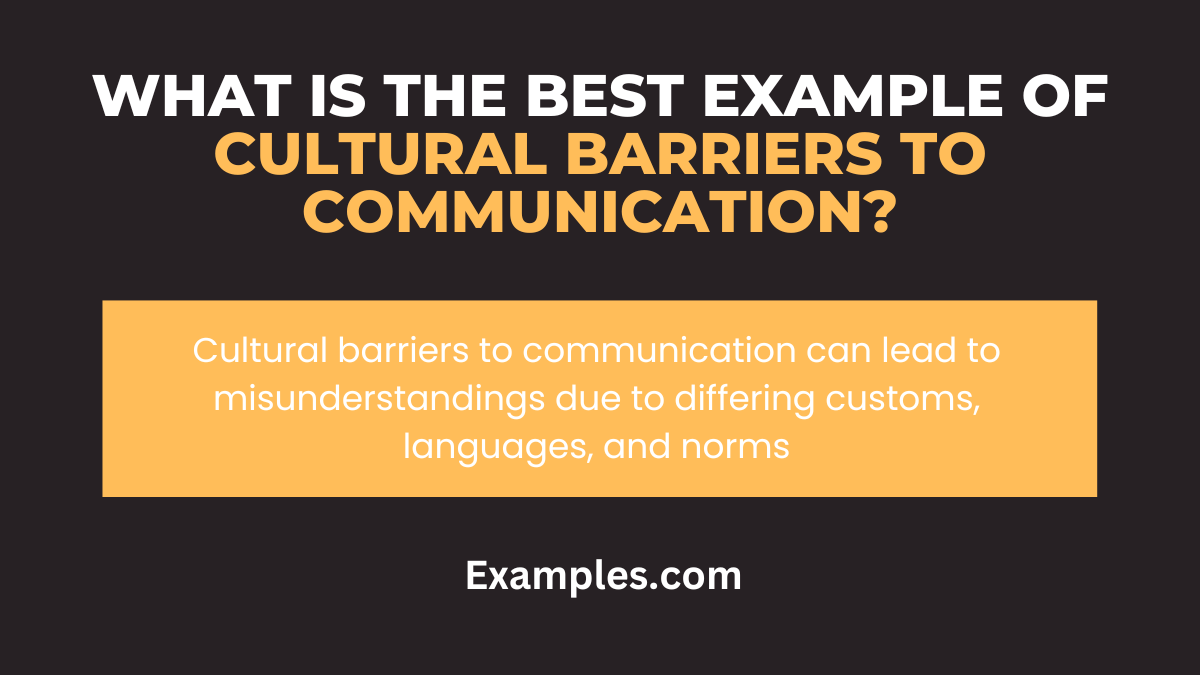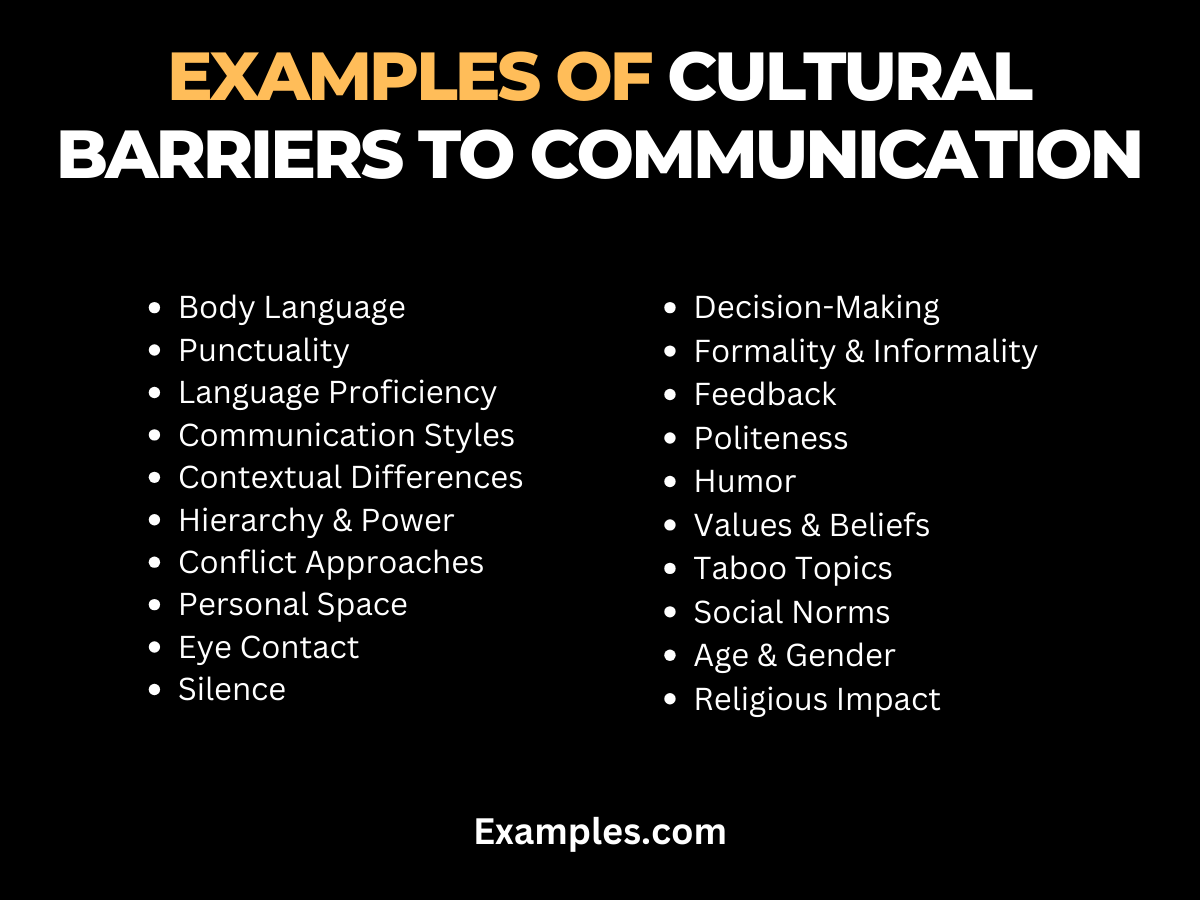19+ Cultural Barriers to Communication Examples
Navigating the intricate world of Cultural barriers to Communication is vital in our globalized society. This segment sheds light on how cultural differences can impede effective communication, and it underscores the importance of cultural sensitivity and awareness. By understanding these barriers, individuals and organizations can foster more inclusive and productive interactions, breaking down walls that hinder mutual understanding and cooperation.
What are Cultural Barriers to Communication?

Cultural barriers to Communication are obstacles in understanding and interaction that arise from differences in cultural backgrounds, beliefs, and practices. These barriers can lead to misinterpretations, misunderstandings, and even conflict, affecting both personal and professional relationships. Recognizing and respecting these differences is crucial in creating a more harmonious and effective communication environment.
What is the Best Example of Cultural Barriers to Communication?

A quintessential example of Cultural barriers to Communication is an international business meeting where participants come from diverse cultural backgrounds. Differences in communication styles, body language, and etiquette can lead to misunderstandings and inefficiencies. For instance, directness in communication may be appreciated in some cultures, while it might be seen as rude in others. Understanding these nuances is key to successful cross-cultural communication.
20 Cultural Barriers to Communication

Cultural barriers to Communication are critical challenges in today’s globalized world. These barriers arise from differences in cultural norms, values, beliefs, and practices, leading to misunderstandings and ineffective interactions. Recognizing and navigating through these cultural differences is crucial for successful communication in various settings, including workplaces, social interactions, and international relations. This guide provides 20 distinct examples of cultural barriers, each illustrating how cultural differences can impact communication and offering suggestions for more effective cross-cultural interactions.
- Varied Interpretations of Body Language: Gestures can have different meanings in different cultures.
Example: “In my culture, this gesture is a sign of respect, not disrespect.” - Different Attitudes Toward Punctuality: Time perception varies across cultures.
Example: “I understand time is more flexible in your culture; let’s agree on a strict meeting schedule.” - Language Proficiency and Accents: Language barriers hinder effective communication.
Example: “Could you please speak slowly? I’m still learning English.” - Contrasting Communication Styles: Direct vs. indirect communication.
Example: “In my culture, we are more direct in our communication.” - Differences in Contextual Communication: High-context vs. low-context cultures.
Example: “I might need more explicit information to understand fully.” - Hierarchy and Power Distance in Conversations: Some cultures emphasize hierarchy more than others.
Example: “Who would be the appropriate person to discuss this matter?” - Varying Attitudes Toward Conflicts: Different approaches to conflict resolution.
Example: “Let’s find a way to discuss this disagreement openly.” - Cultural Norms Around Personal Space: Personal space preferences differ.
Example: “In my culture, we usually stand a bit farther apart while talking.” - Eye Contact Norms: In some cultures, direct eye contact is aggressive.
Example: “I’m not being disrespectful; avoiding eye contact is a sign of respect where I come from.” - Perceptions of Silence: Silence is valued differently across cultures.
Example: “In our meetings, feel free to take a moment of silence to think.” - Cultural Approaches to Decision Making: Some cultures value group consensus, others individual decision.
Example: “How does your team usually reach a decision?” - Expectations of Formality and Informality: Varying degrees of formality in interactions.
Example: “Is it appropriate to address you by your first name?” - Cultural Norms in Giving and Receiving Feedback: Direct criticism vs. constructive feedback.
Example: “In our culture, feedback is often given in a more indirect way.” - Interpretations of Politeness and Rudeness: Cultural differences in what is considered polite or rude.
Example: “Just to clarify, my directness is not meant to be rude; it’s typical in my culture.” - Cultural Differences in Humor: Humor varies greatly across cultures and can be misinterpreted.
Example: “I realize our humor might not translate well; let’s be mindful of our jokes.” - Differing Values and Beliefs: Core cultural values influencing communication.
Example: “Our viewpoints might differ due to our cultural backgrounds.” - Taboo Topics in Conversation: Certain subjects may be sensitive or inappropriate in some cultures.
Example: “Is this topic acceptable to discuss in your culture?” - Cultural Norms Around Meals and Socializing: Food and social etiquette vary widely.
Example: “I would love to learn about the dining etiquette in your culture.” - Cultural Perceptions of Age and Gender: Age and gender can influence communication dynamics.
Example: “In my culture, age and gender play a significant role in how we communicate.” - Holiday and Religious Observances Affecting Communication: Respect for cultural holidays and practices.
Example: “Please let us know if any of our meeting dates conflict with your cultural observances.”
Addressing these Cultural barriers to Communication requires sensitivity, understanding, and adaptability, fostering more inclusive and effective communication across diverse cultural landscapes.
Impacts of Cultural Barriers to Communication
Understanding the impacts of Cultural barriers to Communication is crucial in today’s diverse world. These barriers can significantly affect personal and professional relationships, leading to misunderstandings and conflicts.
- Misunderstandings in Interactions: Differences in cultural norms can lead to misinterpretations.
- Reduced Workplace Harmony: Cultural misalignments can create tension among colleagues.
- Ineffective Global Business Negotiations: Miscommunication can hinder international business success.
- Impeded Learning and Development: Cultural barriers can restrict educational growth.
- Challenges in Healthcare Delivery: Misunderstandings can affect patient care quality.
- Difficulties in Legal and Social Services: Cultural nuances can complicate legal proceedings.
- Hindered Diplomatic Relations: Misinterpretations can affect international relations.
- Obstacles in Customer Service: Cultural misunderstandings can lead to customer dissatisfaction.
Significance of Cultural Barriers to Communication
Recognizing the significance of Cultural barriers to Communication enables us to navigate through diverse interpersonal and professional scenarios more effectively.
- Promotes Cultural Sensitivity: Understanding barriers encourages respectful interactions.
- Enhances Global Business Strategies: Knowledge of cultural differences aids in international dealings.
- Improves Team Dynamics: Awareness leads to more cohesive work environments.
- Enriches Personal Relationships: Sensitivity to cultural nuances deepens connections.
- Facilitates Effective Education: Teachers can tailor methods to diverse classrooms.
- Informs Healthcare Practices: Culturally informed care improves patient outcomes.
- Strengthens Diplomatic Efforts: Recognizing barriers aids in international diplomacy.
- Refines Marketing Strategies: Understanding cultural contexts enhances brand appeal.
Importance of Cultural Barriers to Communication
The importance of addressing Cultural barriers to Communication cannot be overstated, as it plays a pivotal role in ensuring effective, respectful, and inclusive communication across various spheres of life.
- Fosters Inclusivity: Acknowledging cultural differences creates inclusive spaces.
- Boosts Business Efficiency: Overcoming barriers streamlines global operations.
- Encourages Mutual Respect: Recognizing differences cultivates respect.
- Improves Conflict Resolution: Cultural awareness aids in resolving misunderstandings.
- Enhances Customer Satisfaction: Understanding leads to better service.
- Supports Diverse Workforce Integration: Helps integrate multicultural teams.
- Advances Global Education Outreach: Aids in reaching diverse student populations.
- Strengthens Community Ties: Enhances communication within multicultural communities.
How to overcome Cultural Barriers to Communication
Overcoming Cultural barriers to Communication is key to fostering effective and harmonious interactions in a multicultural world.
- Cultural Awareness Training: Educate yourself and others about different cultures.
- Use of Clear and Simple Language: Avoid jargon and idiomatic expressions.
- Employ Translation Services: Facilitate understanding through professional translators.
- Active Listening: Pay attention to non-verbal cues and context.
- Feedback for Clarity: Ensure messages are understood as intended.
- Respect for Cultural Differences: Show openness and respect for diversity.
- Flexible Communication Styles: Adapt your style to different audiences.
- Encourage Open Discussion of Cultural Norms: Promote dialogue about cultural expectations.
Cultural barriers to Communication present significant challenges in our interconnected world, but they also offer opportunities for growth and understanding. By recognizing their impacts, significance, and importance, and employing strategies to overcome them, we can enhance our ability to communicate effectively across cultures. This guide serves as a comprehensive resource for navigating and improving communication in diverse cultural landscapes.
19+ Cultural Barriers to Communication Examples

Navigating the intricate world of Cultural barriers to Communication is vital in our globalized society. This segment sheds light on how cultural differences can impede effective communication, and it underscores the importance of cultural sensitivity and awareness. By understanding these barriers, individuals and organizations can foster more inclusive and productive interactions, breaking down walls that hinder mutual understanding and cooperation.
What are Cultural Barriers to Communication?

Cultural barriers to Communication are obstacles in understanding and interaction that arise from differences in cultural backgrounds, beliefs, and practices. These barriers can lead to misinterpretations, misunderstandings, and even conflict, affecting both personal and professional relationships. Recognizing and respecting these differences is crucial in creating a more harmonious and effective communication environment.
What is the Best Example of Cultural Barriers to Communication?

A quintessential example of Cultural barriers to Communication is an international business meeting where participants come from diverse cultural backgrounds. Differences in communication styles, body language, and etiquette can lead to misunderstandings and inefficiencies. For instance, directness in communication may be appreciated in some cultures, while it might be seen as rude in others. Understanding these nuances is key to successful cross-cultural communication.
20 Cultural Barriers to Communication

Cultural barriers to Communication are critical challenges in today’s globalized world. These barriers arise from differences in cultural norms, values, beliefs, and practices, leading to misunderstandings and ineffective interactions. Recognizing and navigating through these cultural differences is crucial for successful communication in various settings, including workplaces, social interactions, and international relations. This guide provides 20 distinct examples of cultural barriers, each illustrating how cultural differences can impact communication and offering suggestions for more effective cross-cultural interactions.
Varied Interpretations of Body Language: Gestures can have different meanings in different cultures.
Example: “In my culture, this gesture is a sign of respect, not disrespect.”Different Attitudes Toward Punctuality: Time perception varies across cultures.
Example: “I understand time is more flexible in your culture; let’s agree on a strict meeting schedule.”Language Proficiency and Accents: Language barriers hinder effective communication.
Example: “Could you please speak slowly? I’m still learning English.”Contrasting Communication Styles: Direct vs. indirect communication.
Example: “In my culture, we are more direct in our communication.”Differences in Contextual Communication: High-context vs. low-context cultures.
Example: “I might need more explicit information to understand fully.”Hierarchy and Power Distance in Conversations: Some cultures emphasize hierarchy more than others.
Example: “Who would be the appropriate person to discuss this matter?”Varying Attitudes Toward Conflicts: Different approaches to conflict resolution.
Example: “Let’s find a way to discuss this disagreement openly.”Cultural Norms Around Personal Space: Personal space preferences differ.
Example: “In my culture, we usually stand a bit farther apart while talking.”Eye Contact Norms: In some cultures, direct eye contact is aggressive.
Example: “I’m not being disrespectful; avoiding eye contact is a sign of respect where I come from.”Perceptions of Silence: Silence is valued differently across cultures.
Example: “In our meetings, feel free to take a moment of silence to think.”Cultural Approaches to Decision Making: Some cultures value group consensus, others individual decision.
Example: “How does your team usually reach a decision?”Expectations of Formality and Informality: Varying degrees of formality in interactions.
Example: “Is it appropriate to address you by your first name?”Cultural Norms in Giving and Receiving Feedback: Direct criticism vs. constructive feedback.
Example: “In our culture, feedback is often given in a more indirect way.”Interpretations of Politeness and Rudeness: Cultural differences in what is considered polite or rude.
Example: “Just to clarify, my directness is not meant to be rude; it’s typical in my culture.”Cultural Differences in Humor: Humor varies greatly across cultures and can be misinterpreted.
Example: “I realize our humor might not translate well; let’s be mindful of our jokes.”Differing Values and Beliefs: Core cultural values influencing communication.
Example: “Our viewpoints might differ due to our cultural backgrounds.”Taboo Topics in Conversation: Certain subjects may be sensitive or inappropriate in some cultures.
Example: “Is this topic acceptable to discuss in your culture?”Cultural Norms Around Meals and Socializing: Food and social etiquette vary widely.
Example: “I would love to learn about the dining etiquette in your culture.”Cultural Perceptions of Age and Gender: Age and gender can influence communication dynamics.
Example: “In my culture, age and gender play a significant role in how we communicate.”Holiday and Religious Observances Affecting Communication: Respect for cultural holidays and practices.
Example: “Please let us know if any of our meeting dates conflict with your cultural observances.”
Addressing these Cultural barriers to Communication requires sensitivity, understanding, and adaptability, fostering more inclusive and effective communication across diverse cultural landscapes.
Impacts of Cultural Barriers to Communication
Understanding the impacts of Cultural barriers to Communication is crucial in today’s diverse world. These barriers can significantly affect personal and professional relationships, leading to misunderstandings and conflicts.
Misunderstandings in Interactions: Differences in cultural norms can lead to misinterpretations.
Reduced Workplace Harmony: Cultural misalignments can create tension among colleagues.
Ineffective Global Business Negotiations: Miscommunication can hinder international business success.
Impeded Learning and Development: Cultural barriers can restrict educational growth.
Challenges in Healthcare Delivery: Misunderstandings can affect patient care quality.
Difficulties in Legal and Social Services: Cultural nuances can complicate legal proceedings.
Hindered Diplomatic Relations: Misinterpretations can affect international relations.
Obstacles in Customer Service: Cultural misunderstandings can lead to customer dissatisfaction.
Significance of Cultural Barriers to Communication
Recognizing the significance of Cultural barriers to Communication enables us to navigate through diverse interpersonal and professional scenarios more effectively.
Promotes Cultural Sensitivity: Understanding barriers encourages respectful interactions.
Enhances Global Business Strategies: Knowledge of cultural differences aids in international dealings.
Improves Team Dynamics: Awareness leads to more cohesive work environments.
Enriches Personal Relationships: Sensitivity to cultural nuances deepens connections.
Facilitates Effective Education: Teachers can tailor methods to diverse classrooms.
Informs Healthcare Practices: Culturally informed care improves patient outcomes.
Strengthens Diplomatic Efforts: Recognizing barriers aids in international diplomacy.
Refines Marketing Strategies: Understanding cultural contexts enhances brand appeal.
Importance of Cultural Barriers to Communication
The importance of addressing Cultural barriers to Communication cannot be overstated, as it plays a pivotal role in ensuring effective, respectful, and inclusive communication across various spheres of life.
Fosters Inclusivity: Acknowledging cultural differences creates inclusive spaces.
Boosts Business Efficiency: Overcoming barriers streamlines global operations.
Encourages Mutual Respect: Recognizing differences cultivates respect.
Improves Conflict Resolution: Cultural awareness aids in resolving misunderstandings.
Enhances Customer Satisfaction: Understanding leads to better service.
Supports Diverse Workforce Integration: Helps integrate multicultural teams.
Advances Global Education Outreach: Aids in reaching diverse student populations.
Strengthens Community Ties: Enhances communication within multicultural communities.
How to overcome Cultural Barriers to Communication
Overcoming Cultural barriers to Communication is key to fostering effective and harmonious interactions in a multicultural world.
Cultural Awareness Training: Educate yourself and others about different cultures.
Use of Clear and Simple Language: Avoid jargon and idiomatic expressions.
Employ Translation Services: Facilitate understanding through professional translators.
Active Listening: Pay attention to non-verbal cues and context.
Feedback for Clarity: Ensure messages are understood as intended.
Respect for Cultural Differences: Show openness and respect for diversity.
Flexible Communication Styles: Adapt your style to different audiences.
Encourage Open Discussion of Cultural Norms: Promote dialogue about cultural expectations.
Cultural barriers to Communication present significant challenges in our interconnected world, but they also offer opportunities for growth and understanding. By recognizing their impacts, significance, and importance, and employing strategies to overcome them, we can enhance our ability to communicate effectively across cultures. This guide serves as a comprehensive resource for navigating and improving communication in diverse cultural landscapes.


